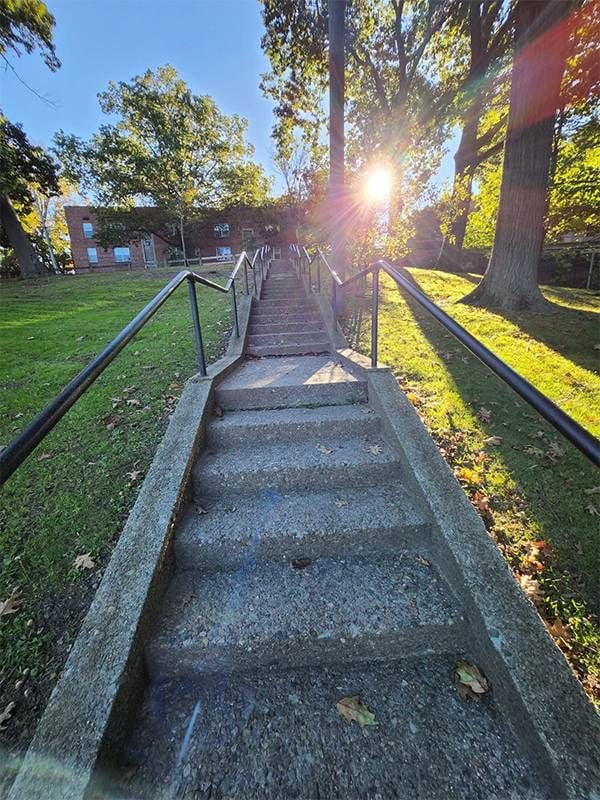Stair Climbing to Better Health
While challenging, stair climbing can help lower the risk of cardiovascular disease and metabolic conditions
I enjoy walking for miles and miles if it is flat, but when I recently had to climb up a set of steep steps to a T station in the Boston suburbs, I was winded. Not to mention embarrassed when my companion was breathing just fine.

Chagrined, I hit the stair climber at the gym later, and within 5 minutes, my jagged breathing had my heart rate in the red zone. Afterward, I spoke to a nearby long-time gym stair climber, and she nodded as she kept pace with the rotating stairs.
"You have to start off slow," she advised. "Then build up over a few weeks or so." I need to work on this, and new research agrees.
Cardiovascular Benefits
A recent Tulane University study with data from more than 450,000 adult participants found that climbing more than five flights of stairs (approximately 50 steps) per day can reduce the risk of atherosclerotic cardiovascular disease by 20%.
I hit the stair climber at the gym later, and within 5 minutes, my jagged breathing had my heart rate in the red zone.
Atherosclerotic cardiovascular disease, or the thickening or hardening of the arteries caused by a buildup of plaque in the inner lining of an artery, includes coronary artery disease, ischemic stroke or acute complications. The study had a median follow-up time of 12.5 years.
"These findings highlight the potential advantages of stair climbing as a primary preventive measure for atherosclerotic cardiovascular disease in the general population," noted study author Lu Qi, MD, PhD, chair and professor at the Tulane University School of Public Health and Tropical Medicine.
"Short bursts of high-intensity stair climbing are a time-efficient way to improve cardiorespiratory fitness and lipid profile, especially among those unable to achieve the current physical activity recommendations," Qi said.
The increased risk of heart disease in more susceptible people could be "effectively offset" by daily stair climbing.
The researchers determined participants' susceptibility to cardiovascular disease using family history, genetics and other risk factors like high blood pressure and smoking history. Lifestyle habits and frequency of stair climbing were also considered.
While the study concluded that climbing more stairs daily significantly reduced the risk of cardiovascular disease in those less susceptible, Qi noted that the increased risk of heart disease in more susceptible people could be "effectively offset" by daily stair climbing.
The availability of stairs makes this an affordable exercise people can fit into daily routines.
Additional Benefits
Daily stair climbing is also associated with a decreased risk for metabolic syndrome, as reported by a 2021 study of late middle-aged men and women.
Data from 782 participants with an average age of 58 years were used to examine the association between self-reported daily stair climbing and metabolic syndrome (a cluster of conditions that occur together and increase the risk of heart disease, stroke and type 2 diabetes).
According to Duke University, stair climbing can also help reduce the risk of injury from falls in older people, aid in maintaining a healthy body weight, and contribute to building and strengthening healthy bones, muscles and joints.
Blue Zone Studies
Research from the Blue Zones demonstrated that people who walk steeply in their daily lives because of their geographic location have improved longevity.
Netflix's documentary "Live To 100: The Secrets Of The Blue Zones" highlighted the experiences of residents from the hilly regions of Sardinia, Ikaria and Costa Rica who have been found to live longer than average.
The series referred to findings of a study by Gianni Pes and colleagues that showed the positive health effects of going up and down the stairs or steep slopes or hills in daily life correlated to longevity in Sardinia.
The researchers noted that these populations maintained a traditional lifestyle with intense physical activity beyond the age of 80, had a reduced stress level, strong family/community support and mainly ate locally produced food.
Add More Stairs to Your Day
The advice to take the stairs instead of the elevator or escalator is an accessible way to incorporate steep walking or stair climbing into daily activity to improve health (be sure to check with your physician before increasing activity or starting a new exercise routine).
You don't have to go on a mountain expedition to get your climb in.
Great options to incorporate the stairs may include the subway, train or bus lines. These easy-access stair areas tend to incorporate brief bursts of steep stairs to help you easily get your steps in.
"If you're already using the steps on your commute, it's time to increase your speed, or take two steps at a time to increase the intensity," said Alicia Jones, a certified fitness instructor specializing in fitness for women over 50.
Personal fitness trainer and over-50 fitness expert Stephen Holt noted people can start with the steps in their homes. "I would advise older people to address stair climbing like another other form of resistance training (with the "resistance" in this case being body weight)," Holt said.
"Depending upon one's current condition, of course, break up stair climbing into 3 to 4 sets spread throughout the day at least twice a week on non-consecutive days," he explained.

"The simplest way to start is with one step (with or without the support of the banister). Start at the bottom, then place one foot on the next step. Then, bring the second foot up to the step so that both feet are now on the step."
"The trick to making this a strengthening exercise is to step up by driving the first foot into the step, as opposed to pushing off with the bottom foot. Repeat by bringing the second foot down each time. The top foot stays stationary on the step until all reps are completed," he said.
Alternate top foot and complete 6 to 8 reps a few times weekly. Working out at the gym can provide the benefits of climbing as well. Michael Sawyer, operations director at Ultimate Kilimanjaro, an expedition company on Mount Kilimanjaro, has experience with intense climbs.
"When you put your body through activities like climbing and steep walking, you are conditioning your body to move blood and oxygen through itself more efficiently because climbing is rather laborious."
"When your body is performing labor-intensive exercise on a regular basis, your cardiovascular system becomes used to productively moving blood around your body and oxygen to your lungs," he said.
However, you don't have to go on a mountain expedition to get your climb in. "A stair step machine, an elliptical, and even a staircase works just as well. For reps, I always recommend starting with about 5 to 10 minutes, then building up to 20 to 30-minute daily climbs," Sawyer said.
Up the Incline
A treadmill is another way for older adults who are new to climbing or steep walking to begin, according to Jones.
"When on the treadmill, you can adjust the incline to your starting level. I suggest 3.5 to start. From there, as you get more conditioned, you can increase the incline," she explained, adding that the treadmill helps in forward walking motion due to the treadmill belt.
Although steep climbing or stepping usually is quite an advanced activity, the ability to adjust the incline and the speed of your walk makes it a much easier starting point, she noted. "The treadmill is also easier on your knees (if you have arthritis or knee pain). Our walking gait is different on a treadmill (we take smaller steps), which makes it easier on our joints," Jones added.
Hit Some Hills
A daily walk or hike that has some hills also can improve your endurance. "Hiking and walking are often some of the most preferred physical activities. Being out in nature and breathing the fresh air makes this vigorous activity feel easy," said Jones.
She recommended finding a hilly yet scenic terrain to hike up, such as smaller hills with peaks and dips to allow for rest in between. Assembling a few friends or joining a walking group can make the activity fun and create more social connections.
No matter which activity you choose, commit to consistently increasing your steps over time. After a recent brunch meet-up with a friend, we walked around the neighborhood. Chatting away, I noticed my breathing catching as we made our way up an incline.
Clearly, I still have some more work to do.


